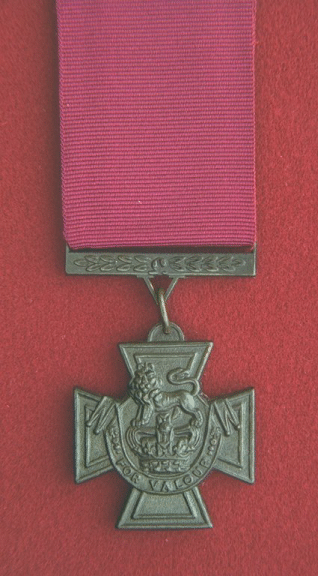Victoria Cross (VC) United Kingdom
Description
Context
The medal was instituted on 05 February 1856 with awards retroactive to 1854. The first award to a Canadian was in February 1857, to Lt. Alexander DUNN (Charge of the Light Brigade).
Eligibility and Criteria
The Victoria Cross is awarded for most conspicuous bravery or some daring or pre-eminent act of valour, self-sacrifice or extreme devotion to duty in the presence of the enemy.
Description
A cross pattee, 1.375 inches wide, with a dark brown finish. Made from cannons captured from the Russians during the Crimean War. For mounting, a straight bar, ornamented with laurels, slotted for the ribbon, has a V-lug below. A small link joins the V-lug to a semi-circular lug on the top of the cross.
The obverse displays the Royal Crown surmounted by a lion guardant. Below the crown, a scroll bearing the inscription: FOR VALOUR.
The reverse contains Raised edges with the date of the act engraved within a raised circle.
The crimson ribbon is 1.5 inches wide and a miniature cross is worn on the ribbon in undress. The ribbon was dark blue for naval recipients until 1918 with Able Seaman William HALL, RN, being the only Canadian VC recipient to wear the blue ribbon.
Bars
A bar is awarded for additional acts of bravery. Only three have been awarded, none to a Canadian.
Historical Notes
- The recipient's rank, name and regiment are engraved on the reverse of the mounting bar.
- There have been 1,351 Victoria Crosses and three Bars awarded worldwide, 99 to Canadians (Canadian-born, serving in the Canadian Army or having a close link to Canada).
- View a list of Canadian recipients
- After more than 135 years of using the Victoria Cross originated by the United Kingdom, Canada established its own version of the medal on 1 January 1993.
